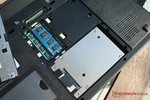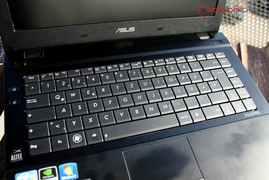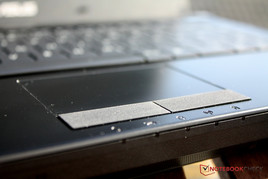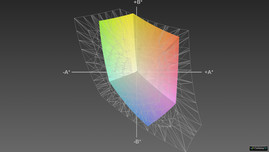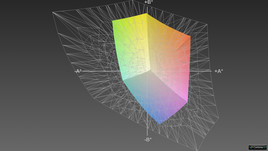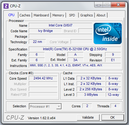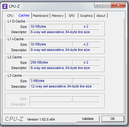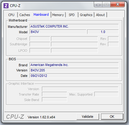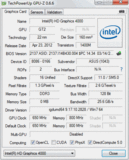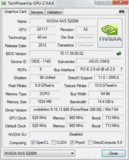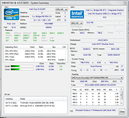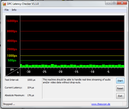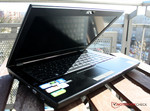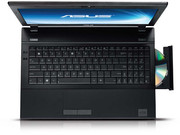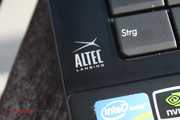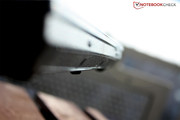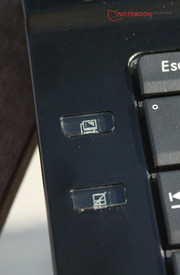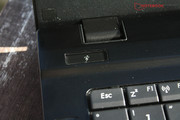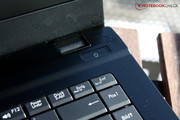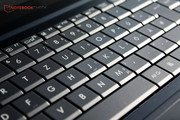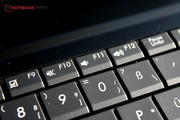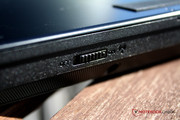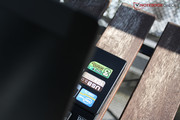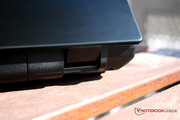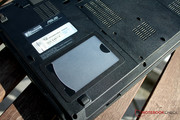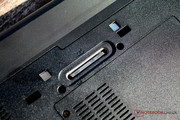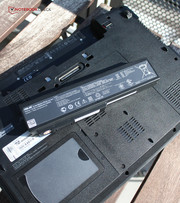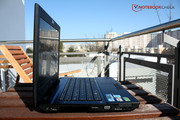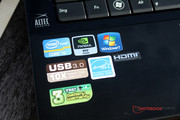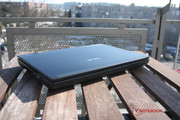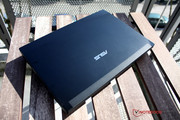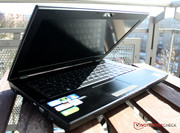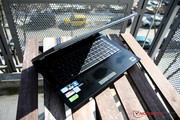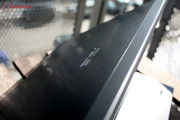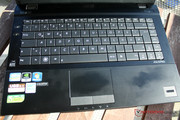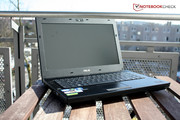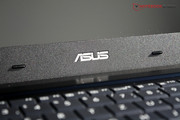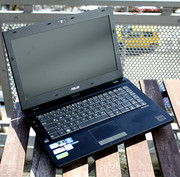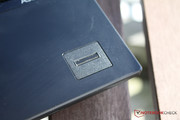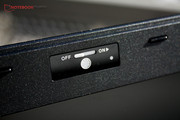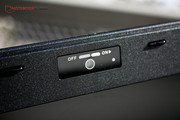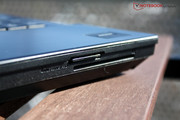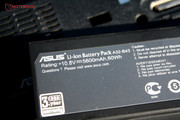Review AsusPro B43V-CU024X Notebook

For the original German review, see here.
For some years now, Asus has tried to establish its Asus PRO series on the market for business notebooks and competed against top dogs like Dell, HP or Lenovo, which already had a good position in many companies. The devices we reviewed so far were convincing overall but could not really differentiate themselves from the established competition.
Maybe this is going to change with the review of the Asus Pro B43V-CU024X: An Intel Core i5-3210M processor and an Nvidia NVS 5200M business graphics card should do the job. With this hardware, the notebook is definitely sufficient for daily office tasks and even has some performance reserves for more demanding work.
Comparable devices would be the Lenovo ThinkPad T430s with the same graphics or the HP ProBook 6 series with devices like the HP ProBook 6465b LY433EA or HP ProBook 6470b. Dell Latitude models are also popular with business customers, for example the Dell Latitude E6430. Even Acer attracts business customers and sends in the TravelMate P643 MG 53214G75Mikk for the competition. We will see if the Asus Pro B43V can assert itself against the competition.
Case
We already reviewed the Asus B43E from the Asus Pro series, which has the same case as our review unit. The price tag for the Asus Pro B43V - CU024X is around 1,000 Euros (~$1308) and comes with certain expectations in the choice of materials and build quality. Asus meets these requirements - at least to a large extent: Cover, palm rest and the keyboard bezel are made of aluminum while the bottom and the display bezel are made of roughened plastics.
Overall, there is not much criticism with the stability. Asus says on its website that due to the aluminum the display cover can resist 20% more pressure compared to consumer notebooks. As a matter of fact, pressure on the display cover is not visible on the screen. At other points we would have hoped for a better quality impression: For example beneath the DVD burner, where the bottom side can be dented with loud cracking noises.
Asus is very confident with the notebook height: Up to 3.5 cm at the thickest point of the Asus Pro B43V. Only the HP ProBook 6465b is 3 mm thicker, otherwise many comparable devices are a bit thinner and lighter.
Connectivity
The port layout of our review unit is also identical to the Asus B43E; the only exception is the lack of a modem port on our unit. This similarity also means that the Asus Pro B43V has a remarkable port variety for a 14-inch device: Thanks to VGA, HDMI and Display-Port almost every display can be connected to our review unit. A 34 mm Express-Card slot is on board as well as eSATA and a 3.5 mm audio jack with S/PDIF support. The docking station port is at the bottom.
Despite the multiple video outputs, the outdated VGA-output is often used at the office. We test it by attaching an external display and the picture quality is good, though close observation reveals a slight blur. We also connect the notebook via HDMI: In this case we get a very sharp picture and can choose every resolution from 800x600 up to 1920x1080.
There could have been more USB ports; however they can be extended very easily with a USB hub. Many ports are at the front area where they can interfere with the use of a connected mouse or opening of the DVD drive. The port layout would be better if some ports were at the back.
Communication
Next to a gigabit LAN connection, the Asus Pro B43V communicates with the outside world via WLAN with all the latest standards and via Bluetooth 4.0. The WLAN module has two antennas; both can receive and transmit simultaneously (2x2). The theoretical bandwidth of the WLAN is 300 MBit/sec; thanks to the dual-band technology the 5 GHz band can also be used. Very good: Even with a distance of 10 meters (~33 feet) and through 3 walls the WLAN reception does not lose any signal strength. A module for wireless Internet over the cellular network is not integrated in our review unit but could be upgraded by the manufacturer. A slot is available beneath the battery cover; however, there are no antennas.
Security
Asus offers quite a lot security and manageability features: The fingerprint reader is immediately visible on the right side of the palm rest. If the required software from Asus is activated and the fingerprint is acquired Windows can be accessed with the successful scan of the fingerprint. In a short test the system worked reliably. Asus Face Logon is also for access protection, it uses the webcam to enable the login via facial recognition. A TPM module is also on board.
Since both solutions are based on windows applications, sensitive data on the hard drive can still be accessed with the installation of a second operating system. To protect this data you can either set a HDD password or encrypt the hard drive. Asus does not deliver a solution for the latter so you have to use third party solutions, or you use the integrated smart card reader that uses a chip card for the login.
The hard drive is protected against damage with a motion sensor, a reinforced metal structure and even an "airbag". In case of a theft, you can use Intel Anti Theft and LoJack. The spill resistant keyboard protects against accidents with liquids and redirects them through a drain away from sensitive components. In-depth information about notebook security can be found in our FAQ-Article.
Accessories
There are not many accessories in the box of the Asus Pro B43V: Next to a cleaning cloth, a rather useless quick start guide and a driver DVD there is nothing in the box, which is at least produced and printed according to ecological criteria.
If the numerous ports of the Asus Pro B43V are not sufficient, you can buy a docking station: Asus sells the Power Station II with the part number 90N0LDK1001Y; it is connected to the device via the docking port at the bottom and is available on the Internet for around 130 Euros (~$170). A detailed test of the Power Station II can be found in the review of the Asus B43E. For around 180 Euros (~$222) you can also find a genuine spare battery on the Internet with the part number 07G016H01875.
Maintenance
Just loosen three screws at the bottom and you have access to the hard drive and RAM modules. They can be easily replaced by the user. If you loosen all the other screws at the bottom you can lift the whole bottom to get deeper into the system and gain access to the processor and mainboard. However, only specialists should do that and you can lose the warranty.
Warranty
Asus notebooks come with a two-year international warranty. That means if your notebook is damaged when you are traveling you do not have to wait until you are back in Germany but send in the device in the respective country and get it back. This warranty can be extended via the Asus Shop for one more year; it is 69 Euros (~$90) for the national version and 79 Euros (~$103) for the international version. There is a special warranty for the battery, it should maintain its full capacity for 3 years otherwise Asus will replace it.
Input Devices
Keyboard
The keyboard of the Asus Pro B43V is not illuminated but has specially shaped keys: rectangular but chamfered at the front. It looks good and helps differentiating the keys without looking. The key travel is quite long and the keys only have limited resistance. Due to the keyboard design with the small spacing and the long travel, you occasionally get caught in a surrounding key during fast typing. Other manufacturers offer better solutions. Otherwise, the consistently spacious keys work reliably and fast typing is no problem.
Special keys can be found in the left area of the case above and next to the keyboard: On the one hand, you can regulate the energy-saving mode and switch between three presets for the desktop and display modes, for instance a presentation. The bottom key activates and deactivates the touchpad. The keys look good but are not always working reliably. Finally, there is a switch at the front that turns the wireless connection on and off (with Windows 8 this switch activates and deactivates the airplane mode).
Touchpad
We already praised the touchpad in the Asus B43E review: the surface is slightly lower than the palm rest, has good gliding capabilities and is quite large for a 14-inch notebook at 94 millimeters (~3.7 inches) diagonally. The rubberized buttons are also very convenient; they have a good pressure point and are pleasantly quiet.
As mentioned before, the touchpad can be deactivated with a push of a button. The input device even recognizes when the whole palm is on the touchpad and deactivates itself. It is good that the touchpad has so many qualities since there is no second input device in the Asus Pro B43V like the famous TrackPoint of Lenovo ThinkPads.
Display
In this price range IPS displays are the exception: None of the listed devices are equipped with an IPS display and the Asus Pro B43V does not have such a high quality panel either. The integrated LED-TN panel by LG Philips can subjectively convince at a first look: It has a high resolution of 1600x900 pixels, a matte finish but also bright colors and subjectively good contrast. The lower priced models of the series have a lower resolution panel of 1366x768 pixels, which is also worse in many other areas. For more information see the Asus B43E review.
| |||||||||||||||||||||||||
Brightness Distribution: 82 %
Center on Battery: 286 cd/m²
Contrast: 336:1 (Black: 0.85 cd/m²)
40.88% AdobeRGB 1998 (Argyll 3D)
59.2% sRGB (Argyll 3D)
39.54% Display P3 (Argyll 3D)
The measured values support the good first impression: Even if the brightness distribution is slightly more uneven than the competition, none of the other panels can reach the average brightness of 270.9 nits. The black value is also excellent by comparison and results in a comparatively good contrast of 335:1. If you come closer you can recognize a distinct screen-door effect, unfortunately it is hard to capture this effect on a picture.
The coverage of color spaces is not so good with our review unit: Neither sRGB nor Adobe RGB can be covered. Professional users who work a lot with pictures or videos have to connect a display with a bigger color space; all other users will hardly notice this flaw.
The picture below show the results of the color analysis with the photo spectrometer X-Rite i1Display 2, once with the factory configuration and once after the calibration with the CalMan5 software. When comparing the results before and after the calibration you basically see that you can improve the display with the correct calibration: While the grayscale shows distinct deviations from the ideal value before the calibration, it is in the acceptable range afterwards. TN-LED panels often overemphasize the blue color components, which results in a blue cast. This is also the case for the Asus B43V; even the calibration cannot change that.
Outdoors the very bright screen and the matte finish are a good combination: Even if working under direct sunlight on very bright days is not possible, shaded places and bright interiors are absolutely suitable working environments for the Asus Pro B43V. Distracting reflections are no problem due to the matte finish.
The TN panel of the Asus Pro B43V has the common viewing angle limitations for this kind of displays as soon as you tilt either yourself or the display upwards, downwards or sideways. Views from the side result in color distortions and loss in contrast. Fortunately, these effects are not so strong with our review unit compared to other displays. However, upwards and downwards the contrast collapses very fast.
Performance
The Intel Core i5-3210M is a very popular processor, we reviewed 15 devices with this CPU during the last six months alone. The mainstream model can easily be cooled and offers sufficient performance even beyond daily office tasks. The graphics card is more exclusive: The Nvidia NVS 5200M is especially adapted for the needs of professional users and companies and should deliver additional performance. Many competitors just use the integrated Intel graphics with less performance.
Processor
The Intel Core i5-3210M is an all-rounder and works well in multimedia notebooks, entry-level gaming notebooks and even office notebooks. Based on the latest Ivy-Bridge architecture and equipped with two cores the processor has a clock of 2.5 GHz. The system can raise this clock via a Turbo-feature up to 2.9 GHz for multi-threaded tasks or even up to 3.1 GHz for single-threaded tasks. The processor also has a transistor block for encoding and decoding of videos that results in a noticeable performance boost without additional CPU load. Intel calls this technology "Quick Sync".
Next to the processor the Intel HD Graphics 4000 is on the same chip and can be activated by the system when additional GPU performance is not necessary. This enables energy efficient operation. Most of the time the system works reliably on its own; the user can also step in and decide which GPU should be active for each application.
The processor shows the expected results in the Cinebench benchmarks. Other notebooks with this processor get similar results. The Turbo-feature seems to work to its full extent. We actually see that the processor raises its clock under load according to the specifications. There are no limitations when the battery is used as long as the "Maximum Performance"-profile is selected in the energy settings.
System Performance
The overall system performance of the Asus Pro B43V is more in the lower end of the chart. Especially in PCMark Vantage the system clearly falls behind compared to, for example, the Lenovo ThinkPad T430s. A comparison of the hard drive score quickly shows that SSD equipped systems can easily achieve a significant lead. The Lenovo notebook also has a 35% advantage thanks to its faster spinning hard drive. All in all the results are mostly limited by the hard drive performance; it is also the limiting part in the Windows Performance Index. This has a negative impact on application starts and will also be noticeable with data intensive applications, for example video editing. For more common tasks, for instance MS Office applications or picture viewing, the slow hard drive will hardly have any impact, aside from possibly longer loading times.
| PCMark Vantage - 1024x768 HDD Score (sort by value) | |
| Asus Pro B43V-CU024X | |
| Lenovo ThinkPad T430s | |
| HP ProBook 6465b LY433EA | |
| Dell Latitude E6430s | |
| Acer TravelMate P643-MG-53214G75Mikk | |
| PCMark Vantage Result | 6481 points | |
| PCMark 7 Score | 2069 points | |
Help | ||
Mass Storage
The Toshiba HDD is not really a highlight of the system. No wonder, since the hard drive only runs at 5,400 rpm and reaches average transfer rates of 82.6 MB/sec. The Lenovo ThinkPad T430s achieves 17 MBit/sec more with the faster hard drive; the HP ProBook 6465b with an SSD is far ahead. Asus could have easily improved the performance of the system significantly; at least the user can replace the hard drive with a faster model. A positive aspect of the hard drive is the low noise development, which we will further investigate in the "Emissions" section.
Graphics
The Nvidia NVS 5200M is especially adapted to the needs of professional users and companies, which means additional stability and highest possible efficiency in particular. You can also use up to four displays (including notebook display) simultaneously with this graphics card. Technologies like CUDA and Open CL allow the use of the GPU for technical and scientific calculations that enable significant performance enhancements in tuned applications.
These graphics cards are not to be confused with the Nvidia-Quadro graphics for mobile workstations. They have more performance and compatibility optimizations for CAD applications.
If we have a look at the synthetic benchmarks for the graphics card it becomes evident that the Nvidia NVS 5200M provides low mid-range performance. That means: Significantly more than the integrated graphics but also 20% slower compared to the GeForce GT 640M in the Acer TravelMate P643. An in-depth review of the CAD performance of the graphics card can be found in the Lenovo ThinkPad T430s review. A difference to comparable consumer graphics cards cannot be found.
| 3DMark 06 Standard Score | 8340 points | |
| 3DMark 11 Performance | 1138 points | |
Help | ||
Gaming Performance
Even though the graphics card is not really intended for gaming, it is quite capable, at least as long as details and resolution are not too high. The native display resolution of 1600x900 seems to be too much for the graphics card, otherwise most of the games are playable in principle. Casual and browser gamers will have no problems with the Asus Pro B43V; a small test of "The Settlers Online" was smooth even in an advanced colony.
| low | med. | high | ultra | |
|---|---|---|---|---|
| Anno 2070 (2011) | 80 | 33 | 21 | |
| Diablo III (2012) | 73 | 56 | 46 | |
| Guild Wars 2 (2012) | 55 | 20 |
Emissions
System Noise
You can hardly hear the Asus B43V due to the quiet fan and the hard drive that produces no loud noises. The fan is even completely deactivated from time to time, with the energy profile "Quiet Office" in particular. In this scenario the Asus B43V is pretty much silent. Under load it is only slightly louder with an average of 35.8 dB (A) produced by the fan.
The notebook is only really noticeable when you insert a DVD: If data is read from the DVD it is very audible with 46.3 dB (A), however this is just temporary noise, for the long-term the DVD drive produces 41 dB (A). This is audible but still okay.
Noise level
| Idle |
| 29.8 / 31.2 / 31.2 dB(A) |
| HDD |
| 31.4 dB(A) |
| DVD |
| 36.6 / 46.3 dB(A) |
| Load |
| 35.8 / 42.9 dB(A) |
 | ||
30 dB silent 40 dB(A) audible 50 dB(A) loud |
||
min: | ||
Temperature
The surface temperatures of the Asus Pro B43V are also pleasantly low, yet this can be expected with a large case. Maximum load produces a peak value of 39.2 degrees Celsius (102.56 Fahrenheit) at the bottom, moving right from the center, below the fan. The palm rest usually remains cool and heats up slightly at most. During idle the surface does not really heat up at all, the bottom gets a bit warmer at the front. Using the notebook on the lap is always possible.
(+) The maximum temperature on the upper side is 36.2 °C / 97 F, compared to the average of 34.3 °C / 94 F, ranging from 21.2 to 62.5 °C for the class Office.
(+) The bottom heats up to a maximum of 39.2 °C / 103 F, compared to the average of 36.8 °C / 98 F
(+) In idle usage, the average temperature for the upper side is 27.6 °C / 82 F, compared to the device average of 29.5 °C / 85 F.
(+) The palmrests and touchpad are reaching skin temperature as a maximum (35.1 °C / 95.2 F) and are therefore not hot.
(-) The average temperature of the palmrest area of similar devices was 27.6 °C / 81.7 F (-7.5 °C / -13.5 F).
Speakers
With office notebooks the speakers are usually neglected, after all you use them to show something to a colleague or watch a movie after hours at most. However, there is an "Altec-Lansing" symbol on the Asus B43V. The American Hi-Fi manufacturer provided the speakers and they really sound better compared to most other speakers in office notebooks. The main reason is that high tones are not so overemphasized compared to many competitors and the result is a warmer and richer sound. For regular music playback with the notebook we still recommend external speakers or headphones.
Energy Management
Power Consumption
We can report high power consumption for the Asus Pro B43V: We measure 65.3 Watts under load, which is more than any other notebook in this category. However, we have to consider the mainstream graphics: As soon as it is deactivated by Nvidia Optimus and the Intel HD Graphics 4000 is active, the values level out for the most part. When the notebook is turned off or in standby, it consumes just minimal amounts of power from the battery or the PSU. This is not always the case with the competition: Usually they consume at least 0.2 Watts when turned off and up to 0.7 Watts in standby.
| Off / Standby | |
| Idle | |
| Load |
|
Key:
min: | |
Battery Runtime
The high-energy consumption of the Asus Pro B43V under load is clearly noticeable in the battery runtimes: Even with the large 61 Wh battery, our review unit fails to stand out from the competition: Only 1:36 hours under maximum load. In the more realistic WLAN scenario and DVD playback, the larger battery shows its advantages: Compared to the Lenovo ThinkPad T430s with similar components but smaller battery our review unit achieves considerably longer runtimes. The maximum runtime for the Asus Pro B43V is determined by the Battery Eater Reader’s Test (minimal brightness, wireless connections deactivated, energy-saving mode and activated Intel HD Graphics 4000). In this scenario the review unit achieves 6:36 hours independence from the grid.
Verdict
Should a freelancer, company boss or authority choose the Asus Pro B43V? Some things in its favor: The display is clearly above the class average considering the brightness and contrast, numerous ports wait for their respective cables and the device remains quiet as long as you avoid the DVD drive. Heat development and battery runtimes also get a "Good" rating. In addition, you get extensive security features from facial recognition to fingerprint reader and Anti-Theft features.
What could prevent the business user from buying? First of all the appearance of the very massive case and secondly the mobility are not going to appeal to everyone. The keyboard also takes some time getting used to and the lacking WWAN module might be an exclusion criterion.
Overall Asus shows that they can compete well in the business market against big players like Lenovo and Dell. Their devices also have weaknesses in this price range. If the mobility is not the main criterion and if you can live with the bulky chassis, with the B43V you get a good office notebook with excellent port variety.








